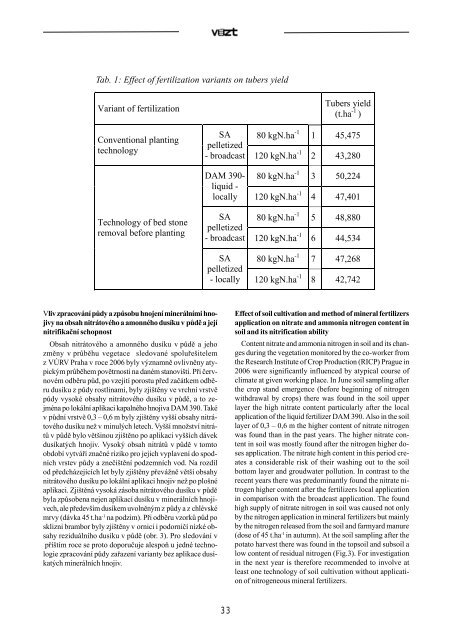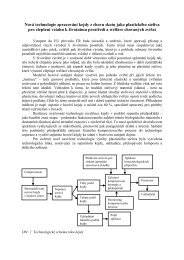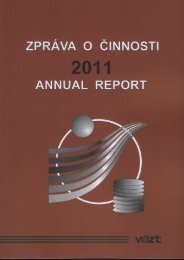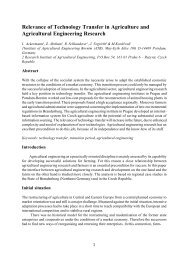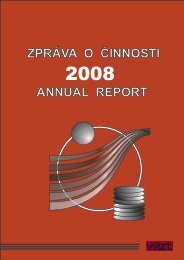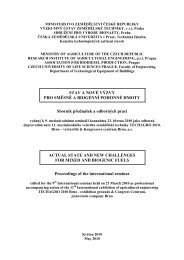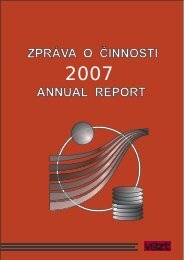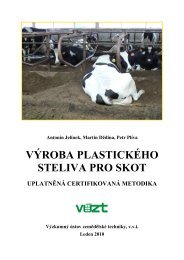Zpráva o ÄÂinnosti v roce 2006 (10MB) - SVT
Zpráva o ÄÂinnosti v roce 2006 (10MB) - SVT
Zpráva o ÄÂinnosti v roce 2006 (10MB) - SVT
Create successful ePaper yourself
Turn your PDF publications into a flip-book with our unique Google optimized e-Paper software.
Tab. 1: Effect of fertilization variants on tubers yield<br />
Variant of fertilization<br />
Conventional planting<br />
technology<br />
Tubers yield<br />
(t.ha -1 )<br />
SA 80 kgN.ha -1 1 45,475<br />
pelletized<br />
- broadcast 120 kgN.ha -1 2 43,280<br />
DAM 390- 80 kgN.ha -1 3 50,224<br />
liquid -<br />
locally 120 kgN.ha -1 4 47,401<br />
Technology of bed stone<br />
removal before planting<br />
SA 80 kgN.ha -1 5 48,880<br />
pelletized<br />
- broadcast 120 kgN.ha -1 6 44,534<br />
SA 80 kgN.ha -1 7 47,268<br />
pelletized<br />
- locally 120 kgN.ha -1 8 42,742<br />
Vliv zpracování pùdy a zpùsobu hnojení minerálními hnojivy<br />
na obsah nitrátového a amonného dusíku v pùdì a její<br />
nitrifikaèní schopnost<br />
Obsah nitrátového a amonného dusíku v pùdì a jeho<br />
zmìny v prùbìhu vegetace sledované spoluøešitelem<br />
z VÚRV Praha v <strong>roce</strong> <strong>2006</strong> byly významnì ovlivnìny atypickým<br />
prùbìhem povìtrnosti na daném stanovišti. Pøi èervnovém<br />
odbìru pùd, po vzejití porostu pøed zaèátkem odbìru<br />
dusíku z pùdy rostlinami, byly zjištìny ve vrchní vrstvì<br />
pùdy vysoké obsahy nitrátového dusíku v pùdì, a to zejména<br />
po lokální aplikaci kapalného hnojiva DAM 390. Také<br />
v pùdní vrstvì 0,3 – 0,6 m byly zjištìny vyšší obsahy nitrátového<br />
dusíku než v minulých letech. Vyšší množství nitrátù<br />
v pùdì bylo vìtšinou zjištìno po aplikaci vyšších dávek<br />
dusíkatých hnojiv. Vysoký obsah nitrátù v pùdì v tomto<br />
období vytváøí znaèné riziko pro jejich vyplavení do spodních<br />
vrstev pùdy a zneèištìní podzemních vod. Na rozdíl<br />
od pøedcházejících let byly zjištìny pøevážnì vìtší obsahy<br />
nitrátového dusíku po lokální aplikaci hnojiv než po plošné<br />
aplikaci. Zjištìná vysoká zásoba nitrátového dusíku v pùdì<br />
byla zpùsobena nejen aplikací dusíku v minerálních hnojivech,<br />
ale pøedevším dusíkem uvolnìným z pùdy a z chlévské<br />
mrvy (dávka 45 t.ha -1 na podzim). Pøi odbìru vzorkù pùd po<br />
sklizni brambor byly zjištìny v ornici i podornièí nízké obsahy<br />
reziduálního dusíku v pùdì (obr. 3). Pro sledování v<br />
pøíštím <strong>roce</strong> se proto doporuèuje alespoò u jedné technologie<br />
zpracování pùdy zaøazení varianty bez aplikace dusíkatých<br />
minerálních hnojiv.<br />
Effect of soil cultivation and method of mineral fertilizers<br />
application on nitrate and ammonia nitrogen content in<br />
soil and its nitrification ability<br />
Content nitrate and ammonia nitrogen in soil and its changes<br />
during the vegetation monitored by the co-worker from<br />
the Research Institute of Crop Production (RICP) Prague in<br />
<strong>2006</strong> were significantly influenced by atypical course of<br />
climate at given working place. In June soil sampling after<br />
the crop stand emergence (before beginning of nitrogen<br />
withdrawal by crops) there was found in the soil upper<br />
layer the high nitrate content particularly after the local<br />
application of the liquid fertilizer DAM 390. Also in the soil<br />
layer of 0,3 – 0,6 m the higher content of nitrate nitrogen<br />
was found than in the past years. The higher nitrate content<br />
in soil was mostly found after the nitrogen higher doses<br />
application. The nitrate high content in this period creates<br />
a considerable risk of their washing out to the soil<br />
bottom layer and groudwater pollution. In contrast to the<br />
recent years there was predominantly found the nitrate nitrogen<br />
higher content after the fertilizers local application<br />
in comparison with the broadcast application. The found<br />
high supply of nitrate nitrogen in soil was caused not only<br />
by the nitrogen application in mineral fertilizers but mainly<br />
by the nitrogen released from the soil and farmyard manure<br />
(dose of 45 t.ha -1 in autumn). At the soil sampling after the<br />
potato harvest there was found in the topsoil and subsoil a<br />
low content of residual nitrogen (Fig.3). For investigation<br />
in the next year is therefore recommended to involve at<br />
least one technology of soil cultivation without application<br />
of nitrogeneous mineral fertilizers.<br />
33


